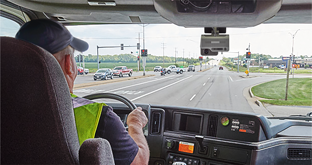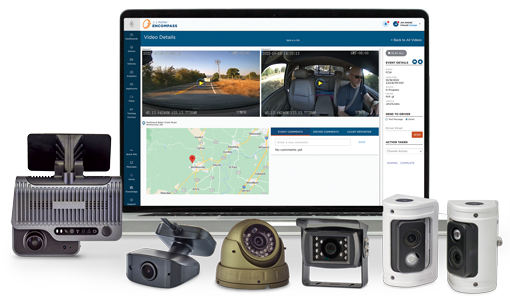Sr. Transportation Management Editor — J. J. Keller & Associates, Inc.
The Payback of Using Dual-facing Dashcams to Coach Drivers
In a typical fleet, 15-20% of drivers represent 80% of the risk. Dual-facing dash cam video footage helps carriers target and correct specific behaviors.
Published On: 10/30/2023


Written by:
Mark Schedler
In a typical fleet, 15 to 20 percent of drivers represent 80 percent of the risk. Read that again – it’s a gamechanger that’s caused many motor carriers turn to video-event monitoring with driver- and road-facing (dual-facing) dashcams. Dual-facing dash cam video footage helps carriers target the drivers with the highest risk and correct specific behaviors identified in the video footage, much like a football coach reviewing game film with the athlete. The goal is always enhancing performance.
Another key benefit of dual-facing dashcams is the opportunity to recognize and reward drivers like consistent driver performance and displays of exceptional skills. Drivers frequently negotiate dangerous situations and don’t often share these events with their leaders. Dashcam allow leaders to highlight positive performance. Dash cams can be one of the most effective retention and recognition tools.
Reducing risk and retaining drivers are always front of mind for fleet managers. And the stats support their reasoning, especially when it comes to unsafe driving, crashes, and litigation. Let’s look at some compelling statistics.
Unsafe driving
Unsafe driving behaviors from a few drivers can risk an entire company's viability. Dual-facing cameras capture behaviors that can be linked to a future risk of accidents, including but not limited to:
- Cellphone use
- Seat belt use
- Fatigued driving/lane drift
- Speeding and hard acceleration
- Hard braking
- Following too close/tailgating
- Cornering too fast
In a recent J. J. Keller survey of 211 fleets, 70 percent of respondents who had implemented dashcams and video-driven coaching of drivers expressed a wide range of dash cam benefits. In fact, their top five responses to the question ”What do you think have been the main benefits of using dashcams?” demonstrated not only reduction in risky driving events, but improvements to training and insurance-related concerns:
- Hard brake events were tracked and analyzed for trends (53% of respondents)
- Improvement in driver training programs (47% of respondents)
- Lower legal fees and litigation risks (45% of respondents)
- Decrease in the number of insurance claims (45% of respondents)
- Decrease in the average value of insurance claims (41% of respondents)
A 2014 study of over 10,000 crashes by the Virginia Tech Transportation Institute (VTTI) found that event-based video systems, combined with driver behavior coaching, accounted for reductions of 20 percent in fatal crashes, and 35 percent in injury crashes.
Crash statistics
Industry crash statistics also provide a compelling case for incorporating video-based coaching. Consider these statistics from the Motor Carrier Management Information System (MCMIS) and Fatality Accident Reporting System (FARS) that reinforce the fact that a primary cause of fatality crashes is human behavior:
- Human choices caused 94 percent of all crashes.
- Thirty-two percent of fatal large truck crashes have at least one truck driver factor as a root cause.
- In at least 75 percent of fatal truck/passenger vehicle-involved crashes, the passenger car driver is at fault.
These stats reinforce the need for capturing road and driver-facing video and conducting related coaching. Sometimes, a dangerous behavior may not be apparent without video. Additionally, having video evidence may exonerate a truck driver of wrongdoing, which leads us to…
Litigation
The American Transportation Research Institute (ATRI) study titled Understanding the Impact of Nuclear Verdicts on the Trucking Industry, published in July 2020, found that in:
- 2006-2010, there were 26 cases over $1 million
- 2015-2019, there were nearly 300 cases over $1 million
The study determined that pre-crash actions by carriers are critical. To avoid the triggers of a nuclear verdict, plaintiff and carrier defense attorneys agreed that:
- "Crash avoidance is EVERYTHING."
- Strict adherence to safety and operational policies is a must.
- FMCSA minimum standards can and should be exceeded.
Carriers should assume all data from the truck or devices and that all actions taken and not taken are discoverable in court. Make sure to:
- Document corrective actions,
- Be proactive and eliminate risky behavior to avoid crashes, and
- Follow performance management policies and procedures consistently.
Proactive correction of unsafe and non-compliant behaviors is imperative. Proactive correction is video-based coaching. When properly conducted, dash cam video-based coaching creates the opportunity for a meaningful engagement between carrier and driver. The carrier can prove their interest and commitment to helping drivers improve their skills, celebrate their good driving, and enable drivers to see and correct their unsafe behaviors and choices.
Make time to talk with a J. J. Keller compliance specialist about using dash cams and driver coaching to reduce crash rates, citations, and other unsafe behaviors in a short timeframe. Our team is trained to provide proper implementation and assist with driver acceptance. Call 855-693-5338 or request a conversation.
You may also enjoy the following articles:
Sign up for our newsletter!
We'll help you stay on top of regulations, best practices, and fleet industry news. Sign up to receive a monthly email notification with links to our most recent blog articles, free resources, and event invites.
